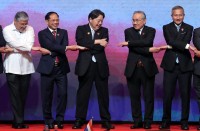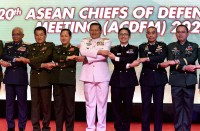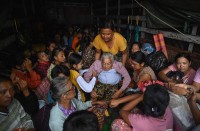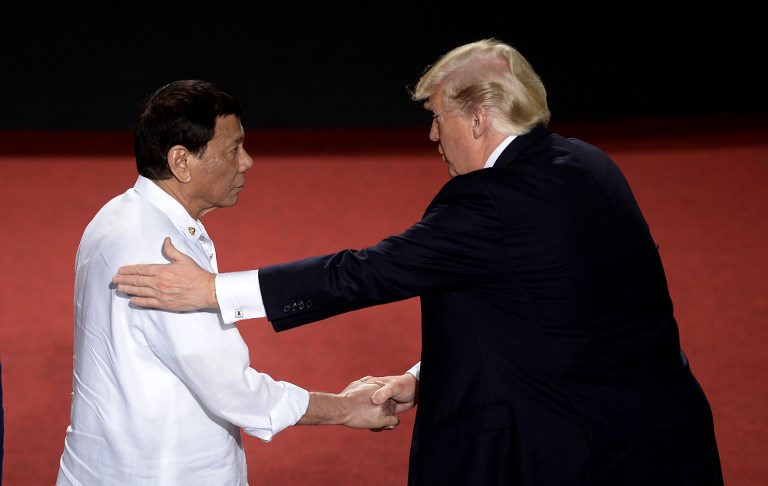
World leaders are in the Philippines’ capital for two days of summits. / AFP PHOTO / AFP PHOTO AND POOL / NOEL CELIS
(Eagle News) — Malacanang released the Philippine-US joint statement on the bilateral meeting between United States President Donald Trump and Philippine President and current ASEAN chair Rodrigo Duterte which mentioned all the important points discussed by the two leaders including freedom of navigation in the South China Sea, the North Korea nuclear threat, the Rohingya crisis in Myanmar, as well as the drug war and the human rights issues.
There was a “broad range of shared interests and priorities” discussed as written in the joint statement.
“They pledged to expand cooperation and reaffirmed their commitment to strengthening the bilateral alliance, a 70-year partnership that has stood the test of time, which ensures both countries’ mutual security and contributes to regional peace, stability, and economic prosperity,” the statement said.
The issue of human rights was even the third point of the Philippine-US joint statement.
“The two sides underscored that human rights and the dignity of human life are essential, and agreed to continue mainstreaming the human rights agenda in their national programs to promote the welfare of all sectors including the most vulnerable groups,” the statement read.
While the human rights issue was discussed, the Philippine government’s ongoing campaign against criminality, including illegal drugs, was also taken up.
“Both sides acknowledged that illegal drug use is a problem afflicting both countries and committed to share best practices in the areas of prevention; enforcement, including capacity-building and transparency in investigations; and rehabilitation,” their statement read.
Another major point of discussion during Monday’s (Nov. 14) bilateral meeting was the North Korea issue.
“Both leaders condemned the unlawful nuclear weapons and missile development by the Democratic People’s Republic of Korea (DPRK) and called on the DPRK to immediately comply with UN Security Council Resolutions and agree to complete verifiable and irreversible denuclearization,” it said.
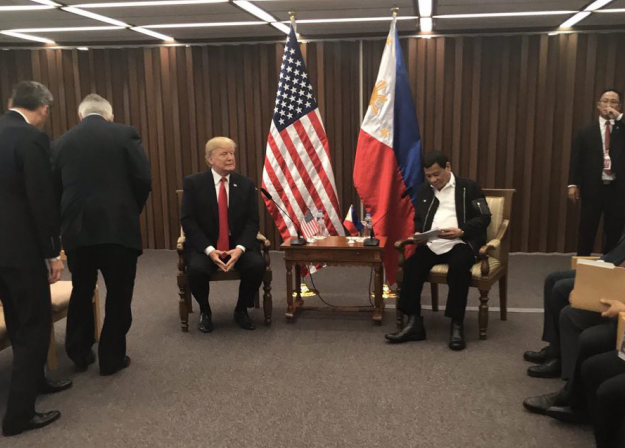
Trump also commended the Philippines for its compliance with the relevant United Nations Security Council Resolutions on North Korea. He also “urged all countries, including those in ASEAN, to voice their opposition to these threatening programs and to take steps to downgrade their diplomatic and economic engagement with North Korea.”
Trump also expressed his condolences to the Filipinos who lost their lives in Marawi City, and vowed that his country would continue to support the Philippines’ fight against terrorism and would help rebuild Marawi City.
The South China Sea issue was also discussed by the two leaders in their bilateral meeting, where “both sides reiterated their commitment to uphold their principles including the freedom of navigation and overflight, and the exercise of self-restraint” in the region.
“They stressed the importance of peacefully resolving disputes in the South China Sea, in accordance with international law, as reflected in the Law of the Sea Convention. They further underscored the need to continue pursuing confidence-building measures to increase mutual trust and confidence, and to refrain from actions that would escalate tensions, including militarization,” the joint statement said.
Trump and Duterte also discussed the “ongoing humanitarian and security crisis in Rakhine State, Myanmar” where they “called for the expeditious delivery of humanitarian assistance” to the affected Rohingya people.
Even the continued defense cooperation between the two countries in the form of the Enhanced Defense Cooperation Agreement (EDCA) was touched, and Trump managed to get the commitment of Duterte to reinforce this based on the released joint statement.
A deeper economic cooperation, a strengthened trade relationship, stronger people to people connections, and institutionalized development capacity between the two countries were also discussed by the two leaders.
During the discussion, Trump praised the 50 years of growth of ASEAN and commended the Philippines for its leadership as ASEAN chair this year.
Below is the full joint statement of the Philippines and the United States:
1. U.S. President Donald J. Trump and Philippine President Rodrigo Duterte met in Manila on November 13, 2017 to discuss a broad range of shared interests and priorities. Both leaders praised the enduring U.S.-Philippines Alliance, built on a strong foundation of shared values, sacrifices, and history, and bolstered by common interests and people-to-people ties, and full respect for legal and diplomatic processes.
They pledged to expand cooperation and reaffirmed their commitment to strengthening the bilateral alliance, a 70-year partnership that has stood the test of time, which ensures both countries’ mutual security and contributes to regional peace, stability, and economic prosperity.
2. On the occasion of the 50th anniversary of the Association of Southeast Asian Nations (ASEAN) and the 40th anniversary of United States relations with ASEAN, the two sides commended ASEAN for its important role in promoting regional peace, stability, and socio-economic development. They pledged to continue to work within the ASEAN framework to pursue these goals throughout the Asia-Pacific. President Trump applauded the Philippines for its leadership as ASEAN chair over the past year.
3. The two sides underscored that human rights and the dignity of human life are essential, and agreed to continue mainstreaming the human rights agenda in their national programs to promote the welfare of all sectors including the most vulnerable groups.
4. Both leaders condemned the unlawful nuclear weapons and missile development by the Democratic People’s Republic of Korea (DPRK) and called on the DPRK to immediately comply with UN Security Council Resolutions and agree to complete verifiable and irreversible denuclearization. President Trump commended the Philippines for its compliance with the relevant UNSC resolutions on the DPRK. The leaders also urged all countries, including those in ASEAN, to voice their opposition to these threatening programs and to take steps to downgrade their diplomatic and economic engagement with North Korea.
5. President Trump expressed his condolences for the tragic loss of life in Marawi City at the hands of ISIS-affiliated terrorists, and congratulated the Armed Forces of the Philippines for its success in liberating Marawi. He vowed continued U.S. support and assistance for the fight against terrorism and the rehabilitation of Marawi. Both sides committed to enhance their counterterrorism cooperation through additional exercises, increased information sharing, and by addressing the drivers of conflict and extremism. Both sides discussed the rehabilitation and reconstruction needs of Marawi and pledged to continue discussions for the rebuilding of Marawi.
6. The two sides reaffirmed their commitment to the Mutual Defense Treaty of 1951, as reinforced by the Enhanced Defense Cooperation Agreement. The two sides discussed proposals to support the United States’ efforts to help modernize the Armed Forces of the Philippines, develop capacity and capability for maritime security and domain awareness, and provide rapid humanitarian assistance. They also reaffirmed their commitment to continue defense cooperation, including by reinforcing respective national defense capabilities and interoperability and enhancing joint activities, disaster response, and cybersecurity.
7. Both sides reiterated their commitment to uphold their principles including the freedom of navigation and overflight, and the exercise of self-restraint. They stressed the importance of peacefully resolving disputes in the South China Sea, in accordance with international law, as reflected in the Law of the Sea Convention. They further underscored the need to continue pursuing confidence-building measures to increase mutual trust and confidence, and to refrain from actions that would escalate tensions, including militarization.
8. They discussed the ongoing humanitarian and security crisis in Rakhine State, Myanmar. Both leaders called for the expeditious delivery of humanitarian assistance to affected communities, and welcomed the Myanmar government’s commitment to end the violence, restore media access, ensure the safe return of displaced persons, and implement all of the recommendations of the Advisory Commission on Rakhine State, and urged all parties to support these government commitments. They expressed their support for ASEAN’s role in working with the government of Myanmar to provide humanitarian assistance.
9. The two sides decided to further deepen the extensive US-Philippine economic relationship. They discussed ways to expand on their mutual commitment to free, fair and balanced trade that increases economic opportunity for all. The two leaders pledged to nurture economic ties, including private sector cooperation, to create jobs and opportunities for people in both countries. To this end, both sides will explore strengthening dialogues for innovation and sharing of best practices in technology to optimize the position of the Philippines as a preferred destination for American investments in the Asia-Pacific region.
10. The two countries recognized the importance of regular discussions under the U.S.-Philippines Trade and Investment Framework Agreement (TIFA) to strengthen the trade relationship including by continuing to make progress in the areas of market access related to agricultural products, intellectual property, customs and labor, among others. The US side welcomed the Philippines’ interest in a bilateral free trade agreement (FTA) and both sides agreed to discuss the matter further through the U.S. – Philippines TIFA.
11. The two sides discussed the ongoing campaign in the Philippines against criminality including illegal drugs. Both sides acknowledged that illegal drug use is a problem afflicting both countries and committed to share best practices in the areas of prevention; enforcement, including capacity-building and transparency in investigations; and rehabilitation.
12. Both leaders stressed the strong people-to-people connections between the Philippines and the United States. They acknowledged the many long-standing institutions that connect people of the two countries, including the longest continuing Fulbright program in the world – a program that has sent more than 3,000 Filipino scholars to the United States and nearly 1,000 American scholars to the Philippines – and the dynamic Young Southeast Asian Leaders Initiative that recently held its annual summit in Manila in October.
13. Both leaders recognized the two countries’ successful cooperation in promoting inclusive development, fueled by good governance, partnerships with the private sector and civil society, and investments in health, education, infrastructure, agribusiness, technology, and democratic institutions. The two sides committed themselves to institutionalizing development capacity, which is the foundation of sustainable stability, growth, and prosperity.
14. President Trump and President Duterte pledged to continue cooperating to promote the mutual goals of peace, stability, and prosperity in the Asia-Pacific region and around the world.

